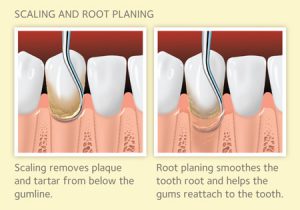DEEP SCALING AND ROOT PLANNING
Periodontic Treatment
DEEP SCALING AND ROOT PLANNING
Scaling is basically the process of removing dental tartar from the surfaces of the teeth. Root planning is the process of smoothen the root surfaces and removing any infected tooth structure. If you have gum disease or gum pocketing, the gum pockets around the teeth will have deepened, thereby allowing tartar deposits to form under the gum line.
The two processes tend to blur together since during the cleaning process, the dentist scales away tartar and performs any necessary root planning at the same time. Any roughness can be planed away to result in a silky smooth surface

DOES IT HURT?
Depending on the depth of the pocket and severity of the root surface irregularity, the dentist may wish to make the area numb so that the process is comfortable for you. Don’t hesitate to discuss with your dentist or hygienist how to best manage any discomfort.
Sometimes if the pockets are not too deep, there may be little or no discomfort during the procedure – even without numbing. The only sensation may be the physical scraping feeling along the teeth as the area is cleaned and smoothened. A root planed root surface free of tartar has a better chance of allowing the gum tissues to heal and reattach to it. As a result, some deep gum pockets can be reduced after a deep cleaning.
WHAT CAN I EXPECT AFTERWARDS?
Discomfort can vary after root planning, but one can expect it to be sorer afterwards since it’s usually in a deeper region under the gums.
The teeth themselves can become a bit more sensitive to temperature, and bleeding might occur for a little while.
Over-the-counter painkillers such as ibuprofen work very well to alleviate discomfort, but stronger painkillers can be given should you need them.
Brushing and flossing can be delayed or done more gently to avoid aggravating any bruised or tender gum areas.
Your dentist or hygienist may recommend salt water or chlorhexidine rinses.


 Open Chat
Open Chat

